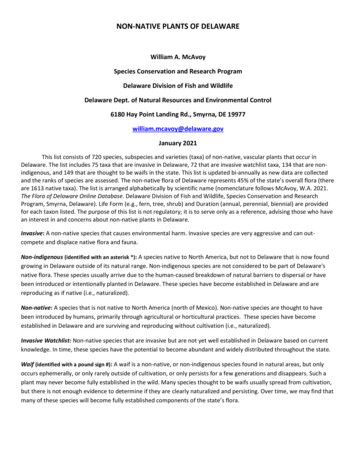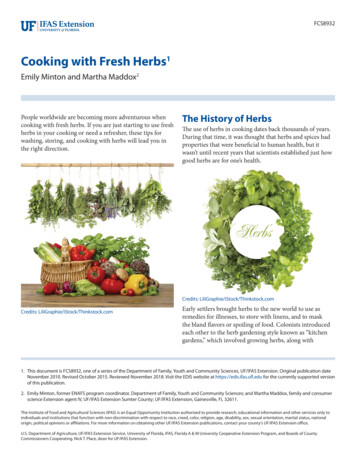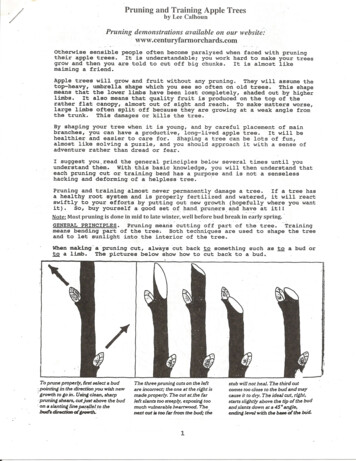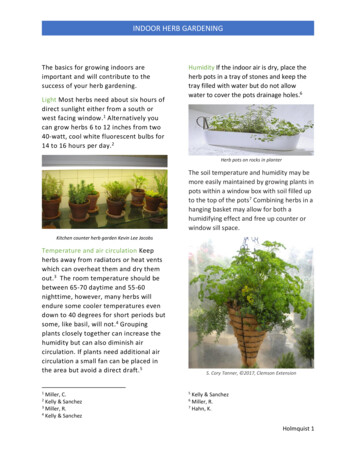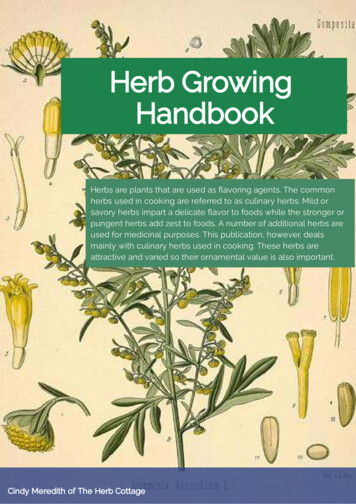
Transcription
Herb GrowingHandbookHerbs are plants that are used as avoring agents. The commonherbs used in cooking are referred to as culinary herbs. Mild orsavory herbs impart a delicate avor to foods while the stronger orpungent herbs add zest to foods. A number of additional herbs areused for medicinal purposes. This publication, however, dealsmainly with culinary herbs used in cooking. These herbs areattractive and varied so their ornamental value is also important.Cindy Meredith of The Herb Cottage
Guide To Successful Herb GrowingThe leaves of most herbs are the part of the plant that is used although theseeds or roots of some herbs can also be used. Herbs are used in smallquantities, so usually only a few plants are necessary to provide su cientfresh and dried herbs for the entire season.LOCATIONThe ornamental value of herbs enables them to be grown in ower beds, inrock gardens as borders or corner plantings, for instance. Many herbs growvery well in pots and containers making them ideal for those without a backor front yard. All that is needed is a small balcony, deck or patio.Many gardeners establish a small herb garden in the area closest to thekitchen making it easy to pop outdoors and clip the fresh herbs needed for ameal. A small 6- to 10-foot square or rectangular area is su cient for anoutdoor, in-ground herb garden. A circle or free-form design can also be used.Container grown herbs can be placed on steps or porch for easy access.theherbcottage.comPage 1
Guide To Successful Herb GrowingAs the Garden GrowsCare for the herb garden is similar to that of a vegetable or owergarden. Select a sunny, well drained location. If you have heavy soil,add organic amendments to make the soil drain better.Water as necessary during dry periods after plants are established.Generally an inch a week is advisable if no rainfall is present.If you have very sandy soil, organic amendments will help your soilretain water, yet still drain well. Addition of a balanced organic fertilizer ifyour soil is very poor may be advisable.theherbcottage.comPage 2
Guide To Successful Herb GrowingMediterranean HerbsSome herbs thrive on drier conditions than others. These are the Mediterraneanherbs and are also many of the common culinary varieties. Thyme, rosemary,lavender, oregano and marjoram do well with little water once established. Thesoil must be extremely well drained especially for lavender and thyme varieties.It is easy to over water this group, so go easy on water and mulch with rocks orgravel to help dry the immediate environment to combat the e ects of highhumidity.Establishing the Herb Gardentheherbcottage.comPage 3
Guide To Successful Herb GrowingEstablish annual and biennial herbs, (basil, parsley, cilantro, fennel, dill)by planting seeds directly in the garden or starting seeds indoors forlater transplanting to the garden.To save your own seed for planting the next season, harvest the entireseed head after it has dried on the plant. Dill, basil, fennel and cilantroare easy varieties to save. Allow the seeds to dry in a protected locationthat is cool and dry. After the seeds are thoroughly dry, thresh the seedfrom the heads and discard the trash. Store the seeds in labeled jars orenvelopes in a dark, cool, dry location.Seeds such as dill, caraway, anise or coriander (the seed from the leafycilantro plant) are also used for avoring. Perennial herbs (oregano,rosemary, chives, lavender, thyme.) can be propagated by cuttings orby division. Chive clumps are easily divided. Cuttings of rosemary areeasily rooted in a light potting soil in a shady location. Ground layeringworks quite well on rosemary, oregano, thymes and lavender.In general, cool season varieties are planted in the fall in most of Texas,and many hardy perennials do best if planted in the fall so their roots canbe established before the stress of summer heat and humidity.theherbcottage.comPage 4
Guide To Successful Herb GrowingHERBS FOR TEXAS GARDENSAloe VeraUse the fresh juice for minor burns,insect bites and rashes. It seems thatthe less care you give this plant, thebetter it grows. Likes shade. Goodpotted specimen as it is only winterhardy in the very southern reaches ofthe state.Perennialtheherbcottage.comPage 5
Guide To Successful Herb GrowingArtemisia speciesPerennial.A group of plants now used mainly forlandscaping because of their silverygray foliage.Includes Wormwood, Southernwood,Silver Queen, Silver King and DustyMiller.Very tough, insect free plants thatshould be used more in the landscape.Not edible.theherbcottage.comPage 6
Guide To Successful Herb GrowingBasilOcimum basilicumAnnualMany varieties including Genovese, Spicy Globe,Lemon, Cinnamon, Holy (Tulsi), Licorice, PurpleRu es, Thai and Sweet.Sweet or Genovese is the tomato herb and astaple in Italian cooking. Freeze the fresh leavesfor future use or make a zesty pesto.Here is a link to an easy Pesto Recipe.And, some ideas for more Pesto.theherbcottage.comPage 7
Guide To Successful Herb GrowingBorageBorago officinalisAnnualYoung leaves taste of cucumber usedin salads. Blue star shaped owers areoften candied and used to decoratecakes and pastries. Or freeze owers inice cubes for a decorative addition totea or lemonade.Borage attracts bees to the garden.Start from seed late fall or early spring.theherbcottage.comPage 8
Guide To Successful Herb GrowingCatnipNepeta catariaTender PerennialCatnip is a multi-purpose plant. The teais very pleasant with a lemon-mintavor and fragrance.Along with fresh catnip planted incontainers indoors year-round, catniptoys lled with dried leaves will provideyour feline friends with hours of fun.But be warned; they may ignore youfor a while!Catnip is very hardy and grows inalmost any soil; self-sows readilytheherbcottage.comPage 9
Guide To Successful Herb GrowingChamomileMatricaria recutitaAnnualFeathery, green foliage with smalldaisy like owers that are used to brewa sleep inducing tea. Also known asManzanilla. Likes cool weather. Sowseed fall/winter for early springblooms. Self sows easily.theherbcottage.comPage 10
Guide To Successful Herb GrowingSourceChivesAllium schoenoprasumPerennialThe smallest member of theonion family. Use leaves togive a mild onion avor todishes. Garlic chives are mucheasier to grow and are used inAsian cooking for their mildgarlic avor. Easy to grow fromseed. To harvest chives, clipo the whole leaf and usewhat you need.theherbcottage.comPage 11
Guide To Successful Herb GrowingCilantroCoriandrum sativumAnnualWell known in Texas for the use of itsleaves in Mexican dishes and salsa.Dried seeds (coriander) have anorangeyavor and are used inpastries, sausage, cooked fruit.Coriander is an important ingredient inpickling spices and curry powder.Likes cooler weather. Plant early in thespring or fall in the southern half of thestate. Di cult to grow during summer.Freeze leaves for summer use in salsaand other dishes.theherbcottage.comPage 12
Guide To Successful Herb GrowingComfreySymphytum officinalisPerennialLarge plant with coarse leaves andwhiteowers. Very invasive onceestablished, so be careful where youplant it. Used mostly for medicinalproperties.Will do wonders when added to acompost pile. Start from division or rootsections. Does well in a largecontainer.Not recommended for internal use.theherbcottage.comPage 13
Guide To Successful Herb GrowingDillAnethum graveolensReseeding AnnualOne of the easiest herbs to grow fromseed. Plant early in the spring or in thefall, it will sprout when it’s ready. Usedfor pickling, with sh, breads andavored vinegars.Freeze leaves for later use. Largegreen caterpillars that love to eat dill,parsley and fennel will turn intoSwallowtail butter ies,soplantenough for you and them!theherbcottage.comPage 14
Guide To Successful Herb GrowingEpazoteDysphania ambrosioidesTender Perennial/Reseeding AnnualA very weedy herb whose main use isto cook with pinto beans to preventgas. Use about 5 medium leaves to apound of beans.Also makes an interesting tea.If you let this plant go to seed you willhave it everywhere.Freeze leaves for later use, as it is notwinter hardy.theherbcottage.comPage 15
Guide To Successful Herb GrowingFennelFoeniculum vulgareBronze FennelAnnual/ Tender PerennialFinnocchio is an Italian variety thatgrows a large above-ground bulb thatis sliced and eaten raw or cooked.Grows like dill with a sweeter, aniseavor. Plant from seed in fall or earlyspring.Bronze fennel is a veryvariety that looks pretty inbed. Leafy parts and driedboth the green and bronzefor avoring.theherbcottage.comPage 16attractivea owerseeds ofare used
Guide To Successful Herb GrowingSourceGarlicAllium sativumAnnualNot a true herb, but often includedin herb listings. Plant bulbs in fall fora late spring harvest. Whole bookshave been written on its cultivationand use. Leaves may be used likechives.theherbcottage.comPage 17
Guide To Successful Herb GrowingLavenderLavandula spp.PerennialWith its gray/green foliage and sweetscented ower stalks, lavender is amust for any herb garden.Can be tricky to grow in the southernhalf of the state.Needs excellent drainage, full sun andgood air ow around the plant tocombat high humidity. A gravel or rockmulch helps keep the surroundingenvironment dry. Many varietiesavailable.theherbcottage.comPage 18
Guide To Successful Herb GrowingLemon BalmMelissa officinalisAnnual/Tender PerennialMember of the mint family with stronglemon scent and avor. Easily startedfrom seed, cuttings, division or roots.Spreads rapidly.Likes some afternoon shade. Useleaves for hot or cold tea, fruit cupgarnish, or anywhere you want a goodlemon avor. Good bee attractor whenin bloom.theherbcottage.comPage 19
Guide To Successful Herb GrowingSourceLemon GrassCymbopogon spp.Annual/Tender PerennialTropical grass prized for its lemonavored leaves. Use leaves in hotor cold tea, in Asian cuisine,soups, with chicken or sh. Rootsare winter hardy in southern halfof the state, in the northernregions with a good mulch. Startfrom division, or seed for avariety known as East IndianLemon Grass.theherbcottage.comPage 20
Guide To Successful Herb GrowingLemon VerbenaTender PerennialAloysia citrodoraA small shrub with very strong lemonscented leaves. Sometimes known asthe Queen of Lemon Herbs, it makes adelicious tea. Start from cuttings ortransplants. Reliably hardy, highlydesirable deciduous shrub.Annualtheherbcottage.comPage 21
Guide To Successful Herb GrowingMintsMentha spp.Perennial)Withalmostendlessvarieties, mints are the hardiest andeasiest herbs to grow. Very invasive,will soon take over any bed they areplanted in, so container growing is agreat option. Mints do well in full sun topart shade with average water. Use inhot and cold tea for a refreshing drink.Some mints are seed grown, but manyof theavored ones: orange,grapefruit, apple, chocolate, ginger,variegated pineapple are easily startedfrom cuttings or by digging rootedstems from the garden.theherbcottage.comPage 22
Guide To Successful Herb GrowingSourceOreganoCras sit amet nibh libero, in gravidanulla. Nulla vel metus scelerisqueante sollicitudin commodo. Craspurus odio, vestibulum in vulputateat, tempus viverra turpis. Fuscecondimentumnuncacnisivulputate fringilla. Donec laciniacongue felis in faucibus.There are over 400 plants that atone time or another have beenused as we use oregano. One ofthe most common and easilyavailable is Greek Oregano, the low,small leaf, spreading variety. Ashrubby variety known as Italian isalso available.Some Greek varieties have verylittle avor, so be sure to taste anyherb plant you are planning topurchase.There are several plants known asMexican Oregano, which are not inthe Origanum family at all, but havea delicious oregano-like avor andare popular for Southwest dishes.Oregano likes well drained soil andlots of sun.theherbcottage.comPage 23
Guide To Successful Herb GrowingParsleyPetroselinum spp.(Biennial) Another must for the herbgarden, parsley also makes anattractive border for aower orvegetable garden.Flat Leaf or Italian Parsley at TheHerb CottageThe two most widely used types arecurly and “Italian” or at-leaf. Manypeople think the at-leaf variety has abetter avor, but it does tend to go toseed more quickly. Both are startedfrom seed with patience, in the fall, asthey are winter hardy in most of thestate.Parsley likes a little shade for summergrowing otherwise full sun brings outthe avor best. Very high in Vitamin C,parsley is a good addition to freshsalads.theherbcottage.comPage 24
Guide To Successful Herb GrowingSourceRosemaryRosmarinus officinalisTender PerennialRosemary is one of the easiestherbs to grow in Texas as it thrivesin our hot climate. It is consideredvery drought tolerant and can bekilled by over watering.Rosemary comes in two basicforms: upright and trailing orprostrate. The trailing variety haslight blue blooms in spring andthroughout the summer.Rosemary is used with pork,chicken and is great on roastpotatoes.Rosemary is easily propagatedfrom cuttings or by groundlayering.theherbcottage.comPage 25
Guide To Successful Herb GrowingSourceRueRuta graveolensPerennialThis herb grows easily from seed ortransplants. The yellow blossomsare a great butter y attractor.In full sun, the leaves and owerscan cause dermatitis in somepeople, so handle it with care (orgloves.).theherbcottage.comPage 26
Guide To Successful Herb GrowingSageSalvia officinalisShort-lived PerennialSage is another plant that doubles as adurable addition to the landscape inTexas if it has good drainage. It is verysensitive to over watering. Thecommon green variety can be grownfrom seed. It appreciates some shadein the afternoons or grow it in dappledlight.Many varieties are available such asgolden, tri-color, pineapple, and clary.Sage is a must for poultry stu ngand for use in “breakfast sausage”.Leaves can be dried for later use.theherbcottage.comPage 27
Guide To Successful Herb GrowingSalad BurnetSanguisorba minorPerennialSalad Burnet is not as commonly seenin nurseries as some other herbs. It iseasy to grow from seed and is veryattractive in the herb garden.Use leaves in salads, salad dressingsor any dish you wish to have acucumber avor without the “burp”.Attractive plant to use for borders.Does best in cooler weather.Sourcetheherbcottage.comPage 28
Guide To Successful Herb GrowingHerbs are such rewarding plants to grow and so versatile. Herb gardens can beneat and tidy with pathways and a geometric design. Herb gardens can be donemore in the cottage garden style with a relaxed and open design. Herb gardenscan be grown in containers on decks, porches and balconies. Herb gardens canbe grown indoors. Herb gardens can be grown in and among vegetable gardensto attract bene cial and predator insects.The choice of plants depends entirely on what you like to do with your herbs.Cooking, crafting, making body care and wellness products, natural dyes or justenjoying the butter ies and bees that herbs bring to the garden are all reasonsto plant and grow an herb garden.Following, are a couple of easy and avorful ways to use yourherbs.For more information on growing and using your herbs, please visit The HerbCottage website, theherbcottage.com.theherbcottage.comPage 29
Guide To Successful Herb GrowingHERB VINEGAR -- SO SIMPLEWhat tastes good, has only two calories per tablespoon and is easy toprepare?Herbal vinegars o er all this and more. They add avor to salads, marinades,saucesStart by picking (or buying) your herbs and washing in cool water. Lay them on paper towelsand allow to air dry.The basic recipe calls for 1 cup fresh herbs to 2 cups vinegar. Use either red or white wine,cider or rice vinegar. (You can use white vinegar, but the nal product will have a sharpertaste.)To strain the vinegar, use a funnel and co ee lter and pour through until all bits and piecesare strained out. That’s it!! Pour into a clean, decorative bottle and add a few sprigs of herbsto decorate and you have just made a real taste treat.Place the dry herbs in a wide-mouth jar, bruise with a spoon and add the vinegar. Cap, shakea little and store in a cool, dark place for 4 to 6 weeks. Check the taste after processing byplacing a teaspoon of vinegar on some bread (French is nice). If you like the taste, you areready to strain the vinegar. If the taste isn’t strong enough, let it steep another week or so, andtry it again.Here are some herbal combinations that work well together. By the end of summer, you’ll beinventing you own “designer vinegar”: chives, dill, parsley parsley, sage, rosemary andthyme basil and thyme garlic chives, lemon grass,lemon thyme dill, chives salad burnet, garlicchives, parsley red rubin or purple ruffles basilwith any lemon herbtheherbcottage.comPage 30
Guide To Successful Herb GrowingLemon Balm Quick Bread1 Cup Sugar8 Tablespoons Butter¼ Cup Lemon Balm Leaves2 Large Eggs1 ½ Cup All-purpose Flour1 Teaspoon Baking Powder⅛ Teaspoon Sale½ Cup MilkGrated Rind of one lemonGrate the lemon peel and remove the juice from the lemon. Reserve the juicefor the glaze.Cream butter, sugar, and nely chopped leaves. Add eggs and beat well to get asmooth consistency. Add remaining ingredients ( our through lemon rind). Pourinto one large or four miniature greased loaf pans. Bake at 350 degrees for 40-45minutes if using a large pan or 25-30 minutes if using miniature pans.Before removing from the pans, use a toothpick to prick holes in the crust.Pour Lemon Balm Glaze over the top while the loaves are still warm.Allow to cool completely before removing from the pan.Loaves can be frozen for later use.Lemon Balm Glaze1/2 cup sugar2 tablespoons nely chopped lemon balm leavesjuice from one fresh lemon (about 4 tablespoons)*TIP: To avoid having bits of chopped herbs in the bread, steep the choppedleaves in the liquid for a half an hour or so. If youtheherbcottage.comPage 31
Guide To Successful Herb GrowingRESOURCESWhen looking for growing and gardening information on herbs, try and ndbooks and articles written speci cally for the southern United States. Manyresources are perfectly good for the midwest, California and the west coast orthe east coast, but do not address the unique growing conditions we have herein Texas.BOOKS for the South and TexasWhat Can I Do With My Herbs? by Judy BarrettSouthern Herb Growing by Madalene Hill and Gwen BarcleyHerbs for Texas by Howard GarrettThe Big Book of Herbs by Arthur O. Tucker and Thomas DeBaggioThe Herb Society of America Encyclopedia of Herbs and Their Uses byDeni BownWEB SITES, GROWING IN TEXASThe Herb CottageAmerican Botanical CouncilAggie HorticultureTexas Gardener MagazineFall GardeningGo Texan Program- click on Publications and E-ZinesHERB ORGANIZATIONSHerb Society of AmericaInternational Herb AssociationAmerican Botanical CouncilGood Luck and Great Gardening to you from The Herb Cottage.Cindytheherbcottage.com cindy@theherbcottage.comtheherbcottage.comPage 32
Many gardeners establish a small herb garden in the area closest to the kitchen making it easy to pop outdoors and clip the fresh herbs needed for a meal. A small 6- to 10-foot square or rectangular area is sucient for an outdoor, in-ground herb garden. A circle or free-form design can also be used.


